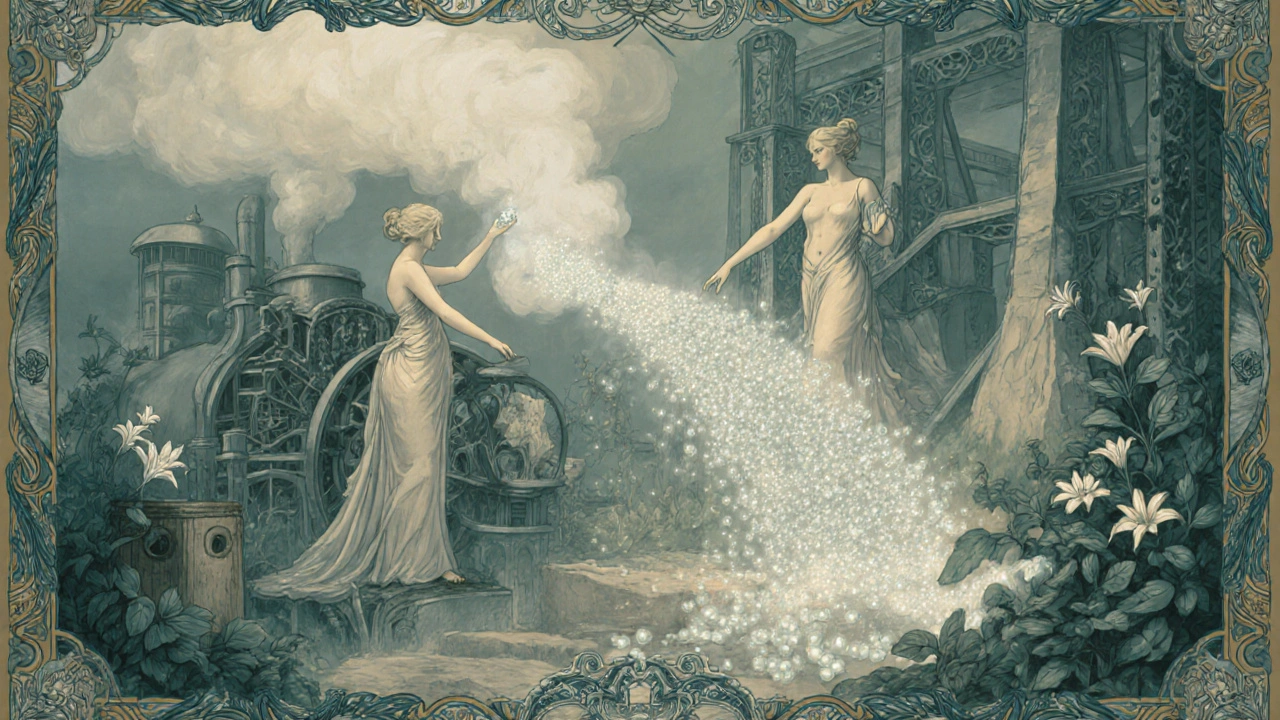How Calcium Carbonate Powers the Paper Manufacturing Industry

Oct, 30 2025
Most people think of calcium carbonate as a supplement for bones or an antacid. But if you’ve ever held a crisp, bright-white sheet of printer paper, you’ve touched one of its biggest industrial uses - paper manufacturing. In fact, over 80% of the calcium carbonate used globally ends up in paper. It’s not just a minor additive. It’s a core ingredient that shapes how paper looks, feels, and performs.
Why Calcium Carbonate Replaced Clay in Paper Making
For decades, clay was the go-to filler in paper production. It was cheap and worked well enough. But by the 1980s, papermakers started hitting limits. Clay made paper brittle. It clogged machinery. And it didn’t give the bright white finish that consumers and printers demanded. That’s when calcium carbonate stepped in.Calcium carbonate, especially the precipitated form (PCC), offered a game-changing upgrade. Unlike clay, it’s chemically pure, non-abrasive, and reflects light better. That meant brighter paper with less ink needed to achieve the same visual impact. It also allowed papermakers to use less wood pulp - cutting costs and reducing environmental strain.
By the early 2000s, Europe and North America had largely switched to calcium carbonate. Today, in high-quality printing and writing papers, calcium carbonate makes up 15% to 30% of the total weight. That’s not a tiny amount - it’s a structural component.
How It Works in the Papermaking Process
The process starts with wood pulp, water, and chemicals. Then calcium carbonate is added as a slurry - fine particles suspended in water. These particles don’t dissolve. They stick to the cellulose fibers during forming, drying, and pressing.Here’s what happens when calcium carbonate is in the mix:
- Opacity increases: Light scatters off the particles, making the paper less see-through. That’s why you can print on both sides of notebook paper without text bleeding through.
- Smoothness improves: The uniform shape of PCC particles fills in tiny gaps between fibers, creating a flat surface ideal for high-resolution printing.
- Whiteness gets boosted: Calcium carbonate is naturally white. It doesn’t need bleaching agents to brighten the paper, reducing chemical use.
- Cost drops: Replacing 10% of wood pulp with calcium carbonate can cut raw material costs by 15% or more.
It’s not magic. It’s physics. The particle size, shape, and surface chemistry of calcium carbonate are carefully controlled. Most papermakers use PCC with particle sizes between 0.5 and 2 micrometers - small enough to fit between fibers, but large enough to scatter light effectively.
Two Types of Calcium Carbonate - And Why It Matters
Not all calcium carbonate is the same. There are two main types used in paper:- Ground Calcium Carbonate (GCC): Mined from limestone, crushed, and purified. It’s cheaper but has irregular shapes and slightly larger particles.
- Precipitated Calcium Carbonate (PCC): Made by reacting lime with carbon dioxide in a controlled chemical process. It forms uniform, needle-like or rhombohedral crystals.
PCC dominates in premium paper. Why? Because its shape and size can be engineered. Need a paper that holds fine ink dots for photo printing? Use PCC with narrow, elongated crystals. Need a thick, opaque paper for brochures? Use broader, more rounded PCC particles.
GCC is still used in lower-grade papers like newsprint or packaging. But for anything that needs to look professional - magazines, catalogs, high-end stationery - PCC is the standard.

Environmental Benefits You Might Not Know
Switching to calcium carbonate didn’t just improve paper quality. It made the whole process greener.Traditional papermaking relies heavily on wood pulp. Trees take decades to grow. Producing one ton of pulp requires about 20 trees and 20,000 gallons of water. Calcium carbonate lets manufacturers use 20% to 40% less pulp per ton of paper.
That means fewer trees cut, less water used, and less energy needed for pulping and bleaching. Plus, calcium carbonate is non-toxic and doesn’t release harmful byproducts during production. It’s also fully recyclable - unlike some synthetic fillers.
European papermakers have led the charge here. In countries like Germany and Sweden, over 90% of coated and uncoated fine papers now use calcium carbonate. The EU even updated its environmental standards to favor carbonate-based fillers over clay.
Challenges and Limitations
It’s not perfect. Calcium carbonate has downsides too.First, it’s alkaline. That’s good for paper longevity - it neutralizes acids that cause yellowing - but it can interfere with certain sizing agents. Papermakers have to adjust their chemical recipes carefully.
Second, it’s heavier than wood pulp. That means more weight per sheet. For shipping and handling, that adds up. A ton of paper with 25% calcium carbonate weighs more than the same ton made with only pulp.
Third, it’s sensitive to acid. If paper gets exposed to acidic environments - like old storage boxes or polluted air - calcium carbonate can dissolve over time. That’s why archival-quality papers often include extra buffering agents alongside the carbonate.
Still, these are manageable problems. Most mills have systems in place to monitor pH levels and control humidity. The benefits far outweigh the trade-offs.

What’s Next for Calcium Carbonate in Paper?
Innovation hasn’t stopped. Researchers are now experimenting with nano-sized PCC particles that can improve strength without adding weight. Others are coating the particles with polymers to make them bond better with fibers.Some companies are even recycling calcium carbonate from waste streams - capturing CO2 from flue gases and turning it into new filler. That’s carbon capture with a practical output: better paper.
By 2030, analysts expect calcium carbonate to make up over 35% of the average paper’s composition in developed markets. That’s up from 28% today. Demand is growing fastest in Asia, where paper consumption is rising and environmental regulations are tightening.
Real-World Impact: From Your Printer to Your Bookshelf
Think about the last time you printed a document. Or opened a new notebook. Or flipped through a glossy magazine. That crisp white surface? That sharp image? That’s calcium carbonate at work.It’s not glamorous. You won’t see it on a label. But without it, paper would be duller, weaker, more expensive, and harder to recycle. It’s the silent partner in every sheet you handle.
Next time you pick up a stack of paper, remember: what makes it feel right, look bright, and last long isn’t just the tree it came from. It’s the limestone beneath your feet - transformed, refined, and repurposed.
Is calcium carbonate safe in paper products?
Yes, calcium carbonate is non-toxic and inert. It’s the same compound found in chalk, antacids, and eggshells. In paper, it doesn’t leach into food or skin, even in direct contact. Regulatory agencies like the FDA and EFSA classify it as safe for use in food packaging and children’s books.
Does calcium carbonate make paper more expensive?
No - it actually lowers costs. While PCC itself isn’t cheap, it replaces more expensive wood pulp. A typical paper mill saves $50-$150 per ton of paper by using calcium carbonate instead of pure pulp. The savings show up in lower prices for consumers, not higher ones.
Can recycled paper still contain calcium carbonate?
Yes. Calcium carbonate doesn’t break down during recycling. It stays in the fiber stream and can be reused over multiple cycles. In fact, recycled paper often has higher carbonate content than virgin paper because it’s easier to retain than wood fibers, which degrade with each recycle.
Why not use titanium dioxide instead for whiteness?
Titanium dioxide gives even brighter white, but it’s 10 to 15 times more expensive than calcium carbonate. It’s also heavier and harder to disperse evenly. Papermakers use it only in ultra-premium products like fine art paper. For 99% of everyday paper, calcium carbonate delivers 90% of the brightness at a fraction of the cost.
Does calcium carbonate affect how ink dries on paper?
It actually helps. Calcium carbonate creates a more uniform surface that absorbs ink evenly. This reduces bleeding and smudging, especially with laser and inkjet printers. High-quality PCC papers are specifically designed for modern digital printing - they dry faster and hold color better than pulp-only papers.
